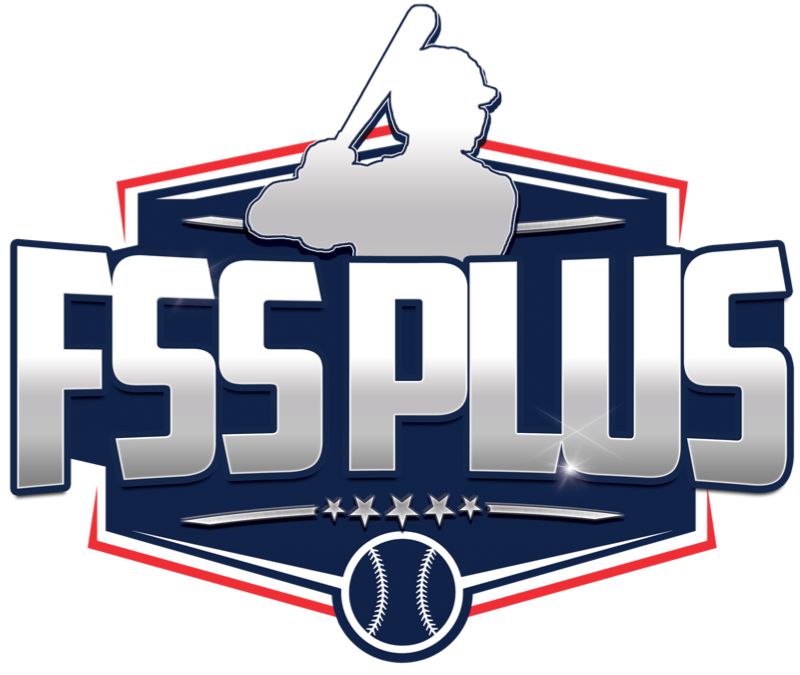And so it begins…
The MLB Draft lottery is finally behind us and we’re one step closer to the 2025 Draft. Granted, we are seven full months away from Rob Manfred taking to the podium, but a step closer nonetheless.
We’ll take a wild shot at the first 43 picks in the Draft here. 43 picks are expected to get us through Competitive Balance Round A in July. Importantly, this draft order is reflective of what we EXPECT the final draft order to look like. Not what it presently looks like right now. Teams are still to be awarded PPI picks. They’re to be awarded compensation picks for lost free agents. Teams will see their draft slots fall ten spots for exceeding the luxury tax by 40 million dollars. A lot is still left to shake out. But when the dust settles, we feel pretty good about this being the final order.
Top 250 Players in the 2025 Draft
With comprehensive, data-driven scouting reports
EDITOR’S NOTE: The following rankings and evaluations by FSS PLUS are based on subjective analysis and industry sources, and do not influence, are not influenced by, or are affiliated with the opinions and reports of Future Stars Series scouting and development staff.
1. Washington Nationals
Jace LaViolette, OF — Texas A&M
HOMETOWN: Katy, Texas
HEIGHT: 6-6
WEIGHT: 230
BAT/THROW: L-L
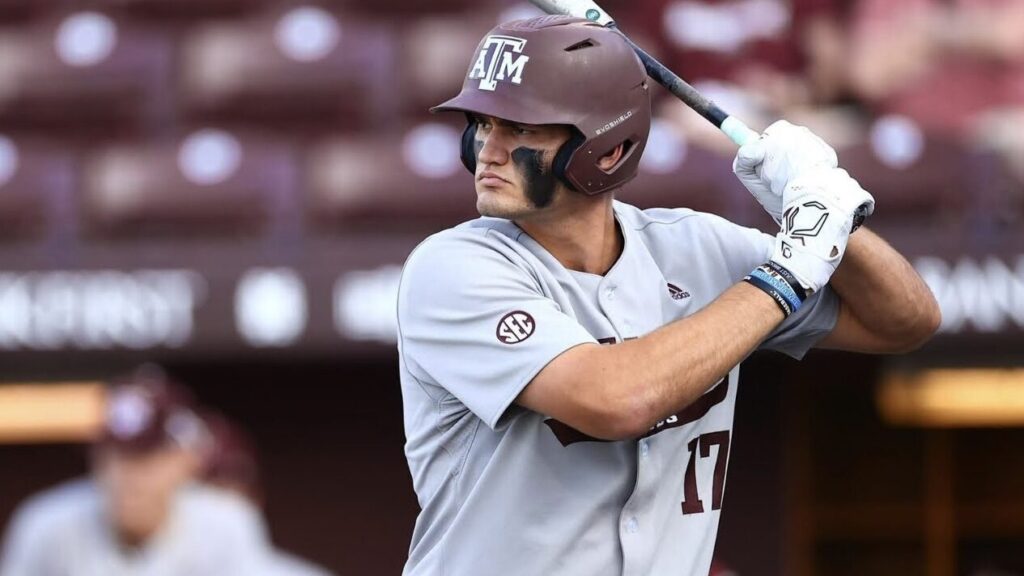
LaViolette currently ranks as the No. 1 player in the 2025 class according to our rankings and there’s no reason not to have him in this spot this early.
LaViolette has established himself as arguably the top college bat currently available in the 2025 Draft. It’s size, it’s physicality, it’s left-handed with borderline elite-level power. There’s a strong approach offensively, above-average run times on the bases and in the field, as well as the chance to play centerfield if only at a fringy level as a pro. Still, he’s tailor-made for right field at the next level where he’d be an asset defensively in almost every way.
LaViolette has shown some swing-and-miss in his game (albeit not an alarming amount of whiffs), but with another year of seasoning, he could see that take a jump in his draft-eligible junior campaign.
LaViolette enjoyed a .305/.449/.726 sophomore season smashing 29 homers and stealing seven bags. He’ll be even more protected in a loaded A&M lineup in 2025 and should see that slash-line bloat to even more impressive levels.
A huge add to the Nationals organization.
2. Los Angeles Angels
Tyler Bremner, RHP — UC Santa Barbara
HOMETOWN: San Diego, California
HEIGHT: 6-2
WEIGHT: 190
BAT/THROW: R-R
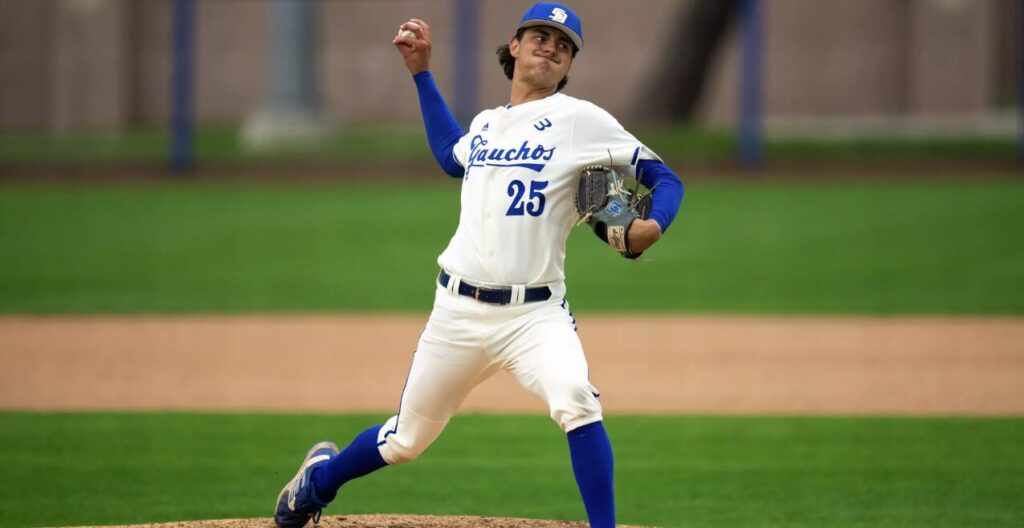
Bremner is a really nice pitching prospect who struck out 104 in just 88.2 innings this spring. He walked just 21 hitters. The fastball has teeth and is already up to 98 mph with big vertical carry. The changeup is his best secondary with some strong fading action and higher spin rates giving it arm-side action. He’s also been developing a sweeper and that’s a pitch that has taken major strides over the last calendar year.
The entire arsenal is thrown out of a deceptive slot; tough for the opposition to pick up, let alone square up. It’s all complimented by above-average control for the strike zone.
The Angels have long needed pitching and Bremner is that in spades.
3. Seattle Mariners
Jamie Arnold, LHP — Florida State
HOMETOWN: Tampa, Florida
HEIGHT: 6-1
WEIGHT: 195
BAT/THROW: L-L
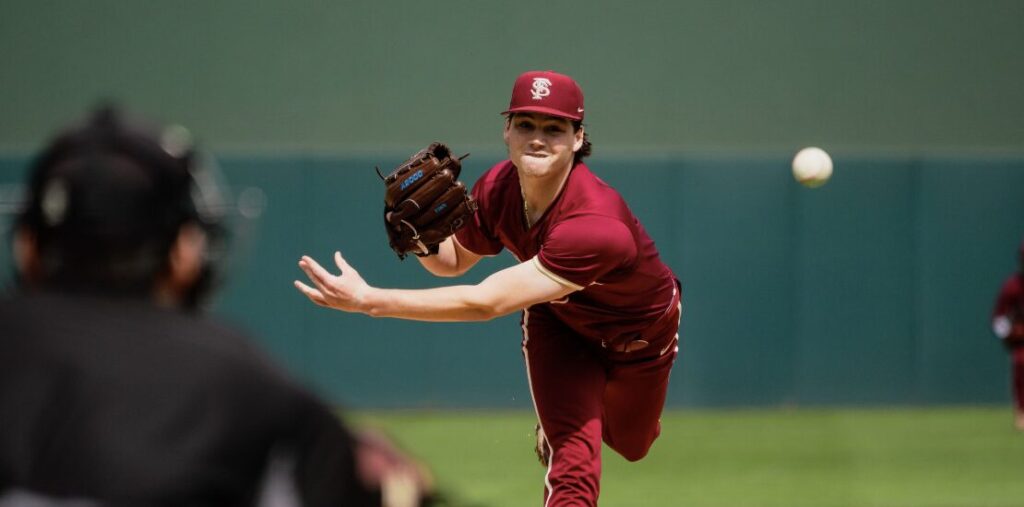
Arnold would be a tremendous get. He’s a metric darling with outlandish release traits and three pitches that project to ‘plus’ right now. Arnold has a chance to pitch in the big leagues in 2026.
In 105.2 innings in 2024, Arnold pitched to a 2.98 ERA with 159 strikeouts and just 26 walks. He was by many accounts the best starting pitcher in college baseball a full year before he’s draft eligible.
Seattle has done remarkably well developing pitching and Arnold could end up atop the organization’s rotation as early as 2027. He’s a unicorn.
4. Colorado Rockies
Aiva Arquette, SS — Oregon State
HOMETOWN: Honolulu, Hawaii
HEIGHT: 6-4
WEIGHT: 220
BAT/THROW: R-R
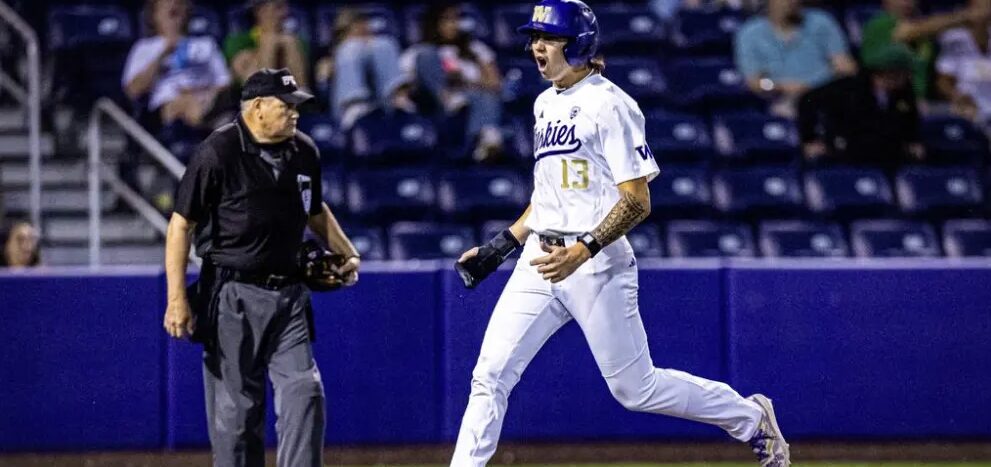
Arquette’s bat took mammoth strides during his sophomore year and now represents one of the most complete sticks in the country. There are bat-to-ball skills and huge exit velocities, both of which were shown off on the Cape too. Arquette has a steady approach and a willingness to use right field, a rare trait for players his size.
If there’s one nitpicking trait scouts would like to see Arquette improve as the Draft nears, it would be his patience at the plate, specifically late in counts. He’s in no rush to take walks. Still, that’s a rather minor wart on a scouting report covered with above-average tools throughout.
Fitting the Rockies land a player being compared to Troy Tulowitzki.
5. St. Louis Cardinals
Billy Carlson, SS — Corona
HOMETOWN: Corona, California
HEIGHT: 6-1
WEIGHT: 178
BAT/THROW: R-R

Carlson is mature well beyond his years at the plate with supreme pitch recognition and a large sample of being able to handle advanced velocity and tough breaking balls. He hits the ball on the ground far too often, but it’s something that can eventually be improved. A lean, wiry frame, Carlson projects to add weight and impact as he develops though he’s unlikely to ever be a power-hitting infielder.
Carlson has a very strong arm that rivals some of the better high school shortstops of the last decade and a soft glove. It’s a shortstop frame with rangy actions and strong hands around the bag.
Carlson also pitches and features a high-spin breaking ball with big lateral action. He’s been up to 95 mph. Most believe his future is on the dirt. Carlson will be 19 years old on draft day.
St. Louis hasn’t been shy going for high-upside preps and Carlson might have the best ceiling of the high school crop. Would be tough for an organization like St. Louis (and Colorado) to walk away from Ethan Holliday though.
6. Pittsburgh Pirates
Gavin Kilen, SS — Tennessee
HOMETOWN: Milton, Wisconsin
HEIGHT: 5-11
WEIGHT: 180
BAT/THROW: L-R
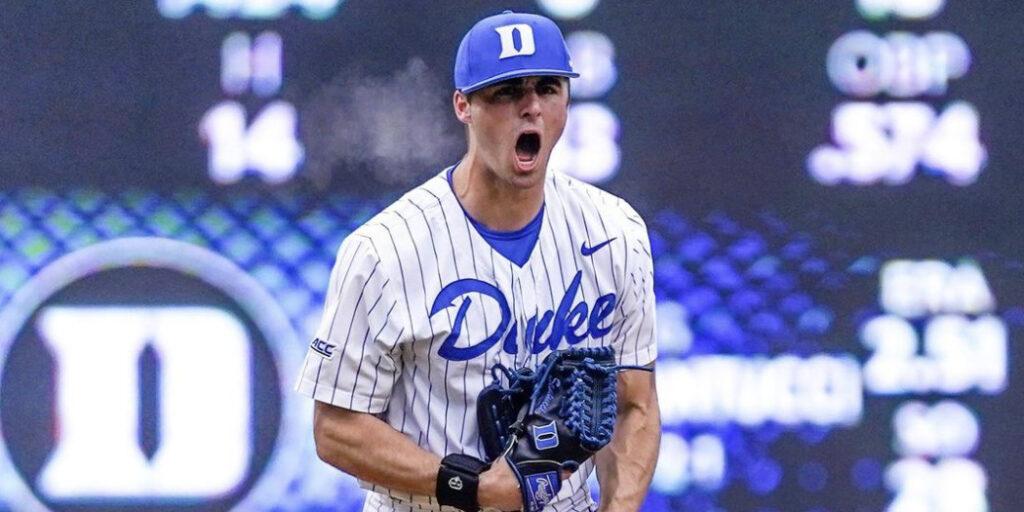
Kilen’s brand is that of a sound hitter with impact still coming. He is extremely aggressive in the box and tends to swing at more pitches than he probably should resulting in well-below average chase rates. Still, he battles, draws long counts, and has largely avoided bloating his strikeout rates. There’s real feel to hit with elite bat-to-ball skills and a willingness to use all fields.
Kilen saw his exit velocities make huge strides in 2024 highlighted by a peak batted-ball event north of 111 mph. He’s growing into average raw power and could be a threat to hit north of 15 homers in 2025. He’s also arguably the top defensive shortstop available in the class.
A good bat and a good get for the Buccos.
7. Miami Marlins
Luke Stevenson, C — North Carolina
HOMETOWN: Wake Forest, North Carolina
HEIGHT: 6-1
WEIGHT: 200
BAT/THROW: L-R

A draft-eligible sophomore, Stevenson walked away from a good paycheck during the 2023 Draft in order to enroll at Chapel Hill. Lauded for his polished hit tool and raw power, Stevenson gets high marks from scouts on his ability to slow down the game at the plate. He takes his walks and puts a jolt into the baseball when mistakes are left over the heart of the plate. He’s proven capable of handling any pitch anywhere in the strike zone, though when he expands the zone he’s had some trouble making contact with the breaking ball. That can sometimes lead to the fear he’ll struggle to hit more advanced spin in professional baseball, though he’s so young at this point and his sample is just one year coming into 2025. Stevenson looked like the total package at times in 2024 as a true freshman with the occasional streaky bouts of getting fooled by the accelerated college game. He has a short, simple, cut-off swing from the left side with a tight, compact turn. He’s got extremely fast hands with considerable raw power that will effortlessly translate to the pro game. There’s some Kyle Schwarber in the operation. Stevenson swings a heavy barrel with loud exit velocities. It’s legitimate impact upside.
Defensively, Stevenson gets green checks for his ability to receive the baseball and has flashed easy ‘plus’ arm strength consistently putting the baseball right on the bag. Already a thick profile, Stevenson figures to stay behind the plate so long as he doesn’t outgrow the flexibility required to catch. As presently constructed, scouts believe he’s comfortably the best defensive catcher in the 2025 Draft with a chance to be one of the more complete catching prospects to come out of the college game in the last handful of years. This is what they look like. Tons of strength in the lower-half and core. He’s pro-ready.
Absolutely gutting that Miami didn’t land a top-three pick in the draft, but Stevenson is a tremendous consolation prize.
8. Toronto Blue Jays
Dean Curley, SS/3B — Tennessee
HOMETOWN: La Verne, California
HEIGHT: 6-3
WEIGHT: 212
BAT/THROW: R-R
Curley is a physical infielder with big bat speed and a mature approach at the place. He has a workman-type attitude and doesn’t get too high or low on the field. Curley leads by example and not with boisterous actions. He’s the type of player who glues the clubhouse together.
He burst onto the scene as a true freshman showcasing immediate impact in 2024 with plenty of slug and impact for the Volunteers. He does exhibit some swing and miss against more premium stuff, but with time and polish could turn into a power-hitting third baseman with a high on-base percentage. That said, don’t try to sneak velocity by Curley because he absolutely eliminates fastballs at any velocity in the strike zone.
Curley has played a good bit of shortstop in the SEC and while his actions aren’t typical of a prototype ‘6’, he has shown the hands and internal clock to play on the diamond at the next level. Curley has a big, strong arm befitting of a corner infielder. He’s an average runner and is a bit heavy-footed on the infield; a trait that generally pushes players out of the middle of the diamond.
He will be a draft-eligible sophomore in 2025 and represents one of the more impactful bats available in the college ranks reminiscent of his peer Christian Moore from the 2024 Draft.
9. Cincinnati Reds
Seth Hernandez, RHP — Corona HS
HOMETOWN: Chino, California
HEIGHT: 6-4
WEIGHT: 195
BAT/THROW: R-R
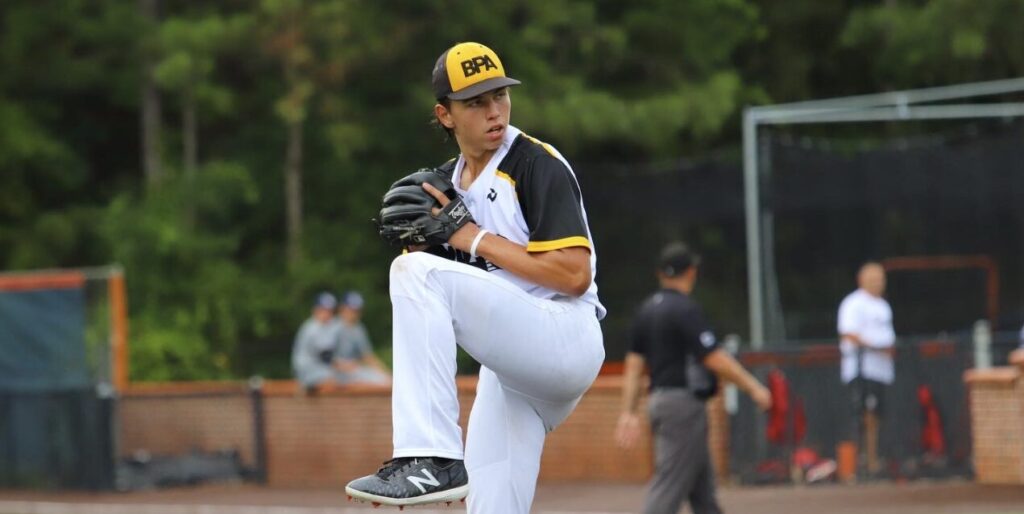
Hernandez might not even be available this late in the Draft but they would welcome another pitching prospect as they’ve found more and more success in developing that profile of late.
The thing that immediately stands out about Hernandez at this stage is his mature pitch-ability and his natural talent to pound the strike zone. He’ll work in the low 90s, grabbing 96 with solid spin and carry through the zone. His best weapon currently is a low-80s slider with solid depth and some sweep, as well as an upper-70s changeup, killing spin well.
Hernandez has a track record against older bats and he’s shredded them up. When you consider the resume, the frame, the projection, and the present feel for the mound, there’s upside here for an impact righty at the next level.
10. Chicago White Sox
Ethan Holliday, 3B — Stillwater HS
HOMETOWN: Stillwater, Oklahoma
HEIGHT: 6-4
WEIGHT: 210
BAT/THROW: L-R

The next Holliday in a long line of decorated impact bats, Ethan follows in his older brother’s footsteps and could become the No. 1 pick this year. But he’s got some work ahead of him in the spring. He’s a much more imposing hitter than his brother was at this same stage with far more projection in the power department than Jackson had/has. He’s already getting a majority of his reps at third base, and shortstop is all but out the window. The hit tool needs to improve, but even if it’s a 40-grade hit tool and 70-grade power, it plays in the top 10 picks.
Holliday is a fluid defender with above-average arm strength and is quick enough to play a strong right field like his father (Matt) if things shake out that way. There will undoubtedly be pressure on the bat considering his already-off-the-middle-of-the-field profile, but scouts and analysts like myself are bullish on the athlete in the box, the projection in the stick, and what the whole package could look like a year from now.
Obviously the White Sox and their fans would be thrilled to land a talent like Holliday here.
11. Oakland Athletics
Cam Cannarella, OF/SS — Clemson
HOMETOWN: Hartsville, South Carolina
HEIGHT: 6-0
WEIGHT: 180
BAT/THROW: L-r
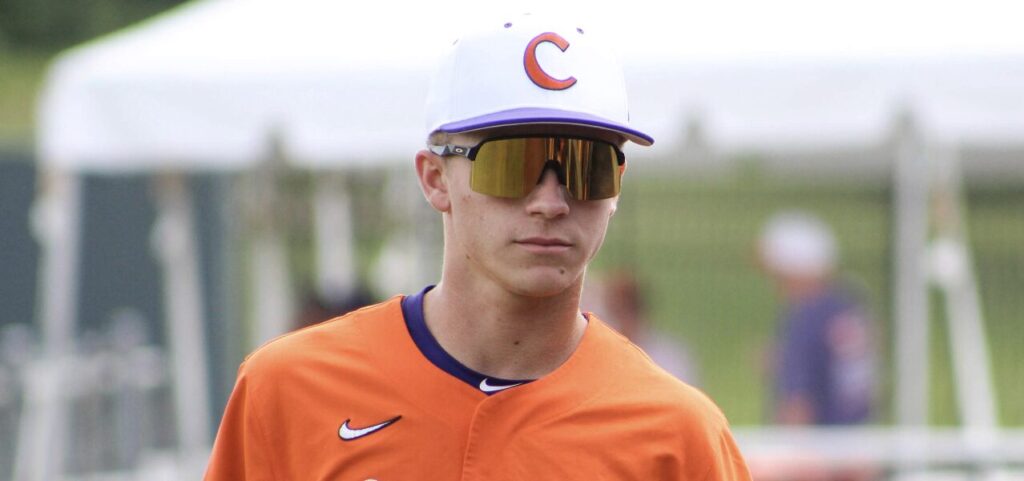
Cannarella possesses borderline elite bat-to-ball skills and a selective, keen eye at the plate. He takes his walks and is a menace on the base paths though he was forced to play more station-to-station in 2024 while dealing with a shoulder injury.
While Cannarella doesn’t possess much more than average raw power, it’s further diluted by his higher-than-preferred ground ball rates. Those will need to improve if he’s to realize his top-ten pick upside. There’s enough raw power to force pitchers to be careful with him and Cannarella has shown an innate feel for the fat part of the bat highlighted by an average exit velocity in as a sophomore that approached 91 mph.
It’s a potential gold glove in centerfield and that should continue to buoy his profile if he never realizes the impact upside at the dish.
12. Texas Rangers
Xavier Neyens, 3B — Mount Vernon HS
HOMETOWN: Mount Vernon, Washington
HEIGHT: 6-4
WEIGHT: 205
BAT/THROW: L-R

Whenever you’re picking this high in the draft you need to go for ceiling and upside. Size, impact, physicality or up-the-middle dynamic traits are a must. Neyens may have the loudest bat of any prep in the 2025 class. It’s comfortably ‘plus’ power with a baseball card that has pummeled guys two years older than him on the showcase circuit for a few years now.
His defensive position is still in question, though he’s made strides at third base and is a good enough athlete to project a potential average glove at the hot corner. If that doesn’t bore out Neyens has a very strong arm and could make for an imposing right fielder. Still, you’re buying the bat here. Neyens has a chance to develop into a guy with 35-plus homer upside and a left-handed stick to boot.
Everything is bigger in Texas and Neyens’ homers fit the bill.
13. San Francisco Giants
Ike Irish, C — Auburn
HOMETOWN: Hudsonville, Michigan
HEIGHT: 6-2
WEIGHT: 203
BAT/THROW: L-R
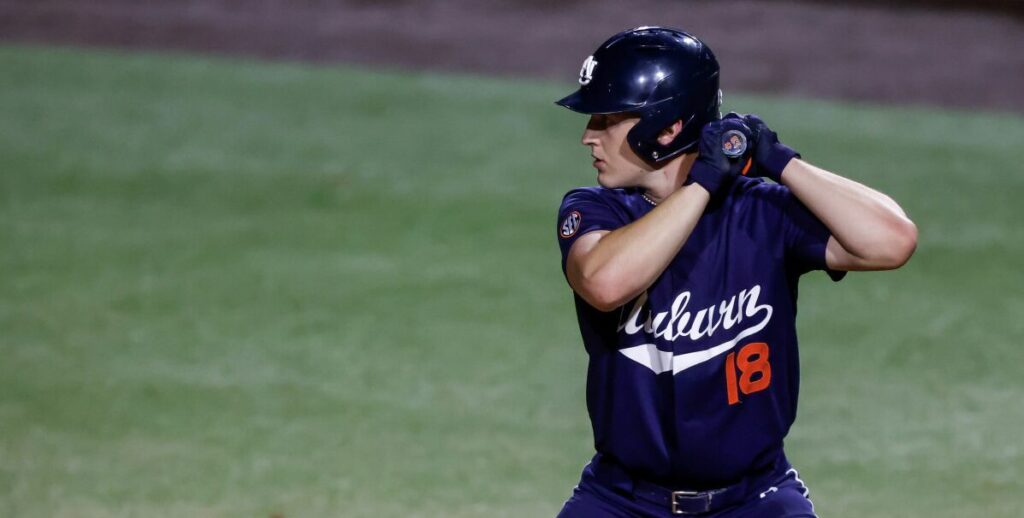
Irish was a first-round talent in high school and has done nothing to dissuade that opinion. He enjoyed a .319/.403/.627 sophomore season blasting 14 homers along the way, hardly ever striking out. All this while playing a stalwart brand of defense behind the plate.
Since arriving to Auburn he’s shown off double-plus raw power and a willingness to pull the ball with authority, hitting high-level SEC pitching consistently and catching a staff of good arms. His bat-to-ball skills are absolutely fantastic, though he can get a little over-anxious and chase at the plate.
Irish ranks among the best in college baseball in making contact with pitches that are in the strike zone. The overall hit tool took a massive jump in 2024 as a whole.
14. Tampa Bay Rays
Devin Taylor, OF — Indiana
HOMETOWN: Cincinnati, Ohio
HEIGHT: 6-0
WEIGHT: 215
BAT/THROW: L-R
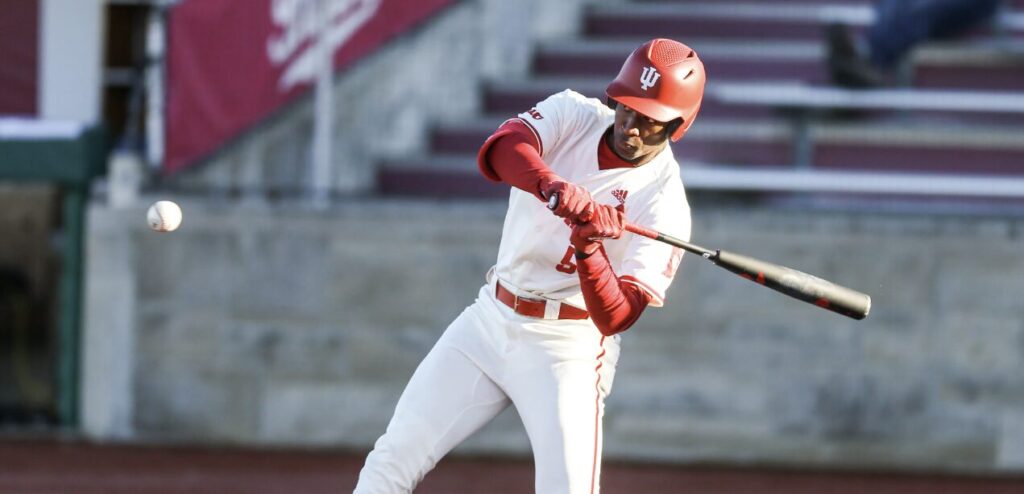
The Hoosiers outfielder enjoyed a very nice sophomore season where he slashed .357/.449/.660 with 20 homers and nearly as many walks as strikeouts.
The profile is led by the bat and he’ll need to once again thump in 2025 if he hopes to realize his top-ten pick ceiling. The defensive tools are limited and Taylor likely ends up in left field, but there’s a chance he’s a .280 hitter capable of depositing 25 homers.
15. Boston Red Sox
Eli Willits, SS — Fort Cobb-Broxton HS
HOMETOWN: Fort Cobb, Oklahoma
HEIGHT: 6-1
WEIGHT: 175
BAT/THROW: B-R
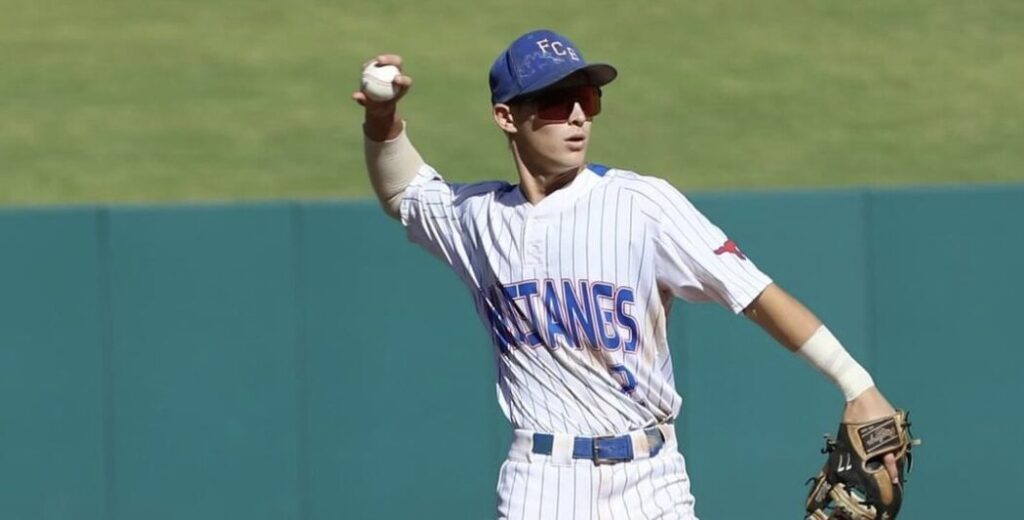
A re-class from 2026, Eli Willits is a true switch-hitter in every sense of the word. Some guys fake it hitting from both sides and struggle from one side or the other. That’s not the case here. From the left side Willits features a tight, compact swing with quick hands and twitchy hips. He uses the whole field and has an adjustability with the barrel that few can match. There’s some moving parts in the load and some late barrel tilt that could test his ability to handle higher velocity arms, but to this point he’s impressed in tournament settings and has had little issue squaring up fastballs in premium settings. Right now it’s fringy raw power with ringing gap power. That said, Willits has a lean frame with the hands and projection you look for in a guy that could ultimately get to average or better raw power. From the right side it’s a bit more bat speed with louder results and a bit more impact to all fields. The hit tool projects better from the left side, but he’s far from a liability as a right-handed hitter. He clearly projects to be able to hit from both sides of the plate going forward. Interesting offensive tools from both sides of the plate.
Willits looks every bit the part of a future shortstop, centerfielder or up-the-middle defender too. He’s a rangy defender who has demonstrated the ability to get to any ball. As a shortstop he excels when coming in on the grass and making the play on slow-rollers in front of him. He can get his body into the athletic positions necessary to make just about every throw. He’s also an above average runner with long strides and a smooth gait that really projects to hold deep into professional ball. He’s also shown plenty capable of playing a strong centerfield if teams want to give him run at the ‘8’. He takes some of the stronger routes in the class out there and demonstrates solid spacial awareness around the wall and warning track.
Perhaps the one nitpick analysts and some evaluators have on the entire profile is a general lack of explosive, twitchy athleticism. Willits doesn’t stand out when it comes to force-plate testing or 30-/60-yard dash workouts. Skeptics of those results will point to a low ceiling from an impact perspective. Those bullish of his profile will point to his extraordinarily young age as means to reason a jump in explosiveness and strength on the horizon.
Willits has a chance to be one of the first players off the board if he adds a bit more impact at the plate. The tools are here for a special player. As noted, he will be extremely young for the draft, just 17.7 years old when he’s selected.
A model-driven pick and a high school shortstop. Two things the Red Sox have coveted in the past.
16. Minnesota Twins
Brendan Summerhill, OF — Arizona
HOMETOWN: Chicago, Illinois
HEIGHT: 6-3
WEIGHT: 205
BAT/THROW: L-R
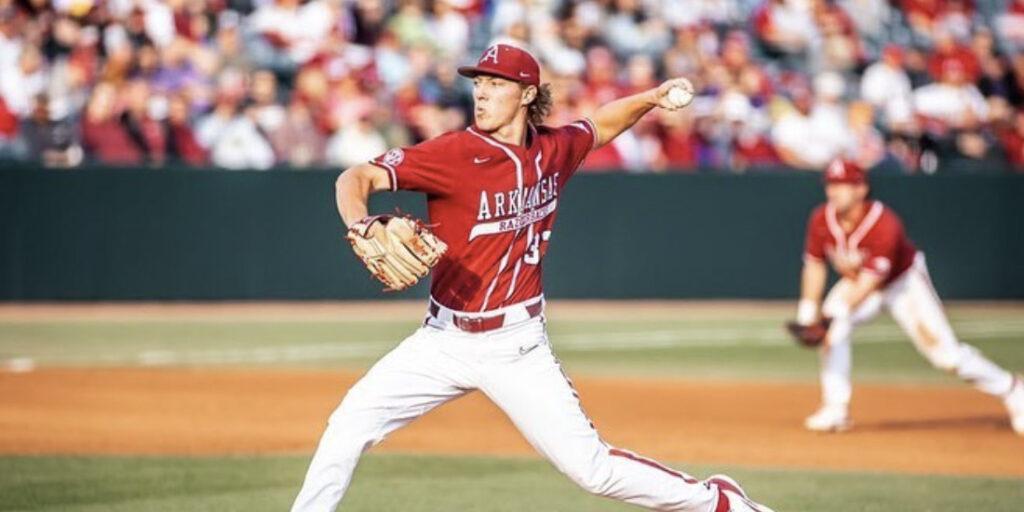
Summerhill is a long-levered, angular outfielder with a sweet, lofty left-handed swing and some present game power largely due to his feel for backspinning the baseball. He’s peaked at 110 mph in terms of exit velocities, but proponents of the profile point toward his leaner frame with strength projection on the horizon as a reason to believe there’s louder contact in the tank. It’s a quiet swing with pull-side authority with almost zero holes in his stroke.
Summerhill posts elite whiff rates and is among the best in the country in terms of in-zone swing-outcome production. There’s a whole lot of polish here and there may be more impact on the way.
Summerhill enjoyed a .324/.399/.550 sophomore campaign with the Wildcats and is doing a ton of damage on the Cape right now all while playing a steady centerfield.
17. Chicago Cubs
Cameron Appenzeller, LHP — Glenwood
HOMETOWN: Springfield, Illinois
HEIGHT: 6-5
WEIGHT: 185
BAT/THROW: L-L
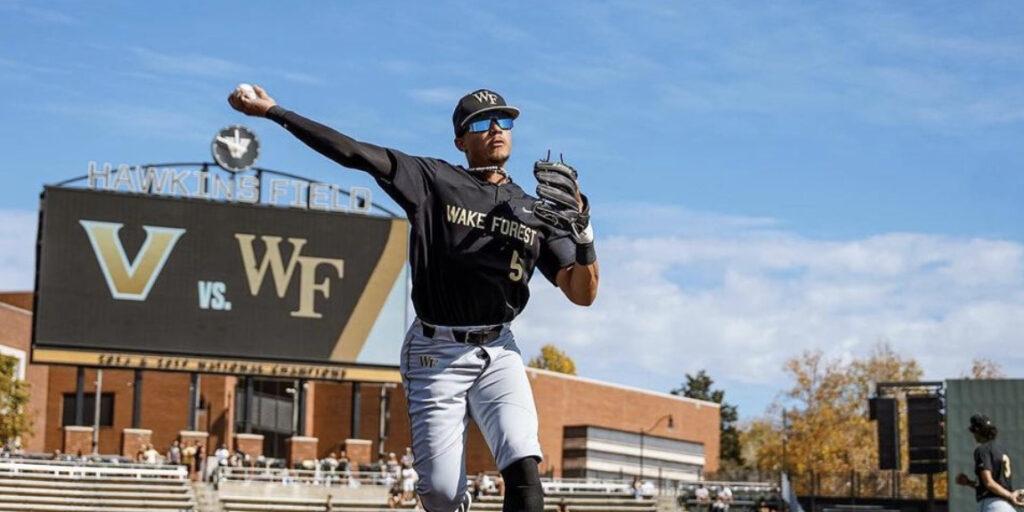
What Appenzeller lacks in present stuff he more than makes up for in terms of projection. This is as good as it gets from an upside perspective. A tall, lean left-hander, Appenzeller lives in low-90s but projects to tick into the mid 90s with his long, wiry frame. He’s already grabbed 94 but is yet to make his anticipated significant velocity jump. It’s a controlled delivery featuring very little effort. The arm action works well with looseness and fluid athleticism, some funk and angles.
Appenzeller throws an above-average low-80s slider that flashes ‘plus’ upside with big two-plane tilt. Appenzeller shows a real understanding for shaping the baseball with a willingness to sweep the ball away from left-handed bats and bury breakers onto the back-foot of righties. The changeup has taken major strides over the last several months and is routinely average with more ceiling coming. It’s a low-to-mid 80s off-speed weapon with strong action into the left-handed batters box.
Appenzeller is one of the more premium arms in the class with strikes, projection, three pitches and a good breaker. A two-sport guy, Appenzeller is also a talented basketball player. Tons to like here with even more to dream on.
18. Arizona Diamondbacks
Henry Ford, OF — Virginia
HOMETOWN: Charlottesville, Virginia
HEIGHT: 6-5
WEIGHT: 220
BAT/THROW: R-R

Ford has easy power and uses every bit of his leverage at the plate. He’s short and direct to the ball with impact bat speed and feel for lift. The exit velocities support the eye test too. The pure hit tool is probably more fringy with whiff rates that can creep north against spin. He’s also an aggressive hitter who has shown a tendency to expand the zone.
Still, Ford’s impact on pitches inside the zone and relative absence of an enormous hole in his swing points toward a middle-of-the-order thumper at the next level — especially considering his size and physicality in the box.
Playoff Teams
19. Baltimore Orioles
Ethan Conrad, OF — Wake Forest
20. Milwaukee Brewers
Nick Dumesnil, OF — Cal Baptist
21. Houston Astros
Tre Phelps III, OF — Georgia
22. Atlanta Braves
Cam Leiter, RHP — Florida State
23. Kansas City Royals
Matt Scott, RHP — Stanford
24. Detroit Tigers
Caden Bodine, C — Coastal Carolina
25. San Diego Padres
Kruz Schoolcraft, LHP — Sunset
26. Philadelphia Phillies
Andrew Fischer, 3B — Ole Miss
27. Cleveland Guardians
Daniel Dickinson, SS — LSU
28. Kansas City Royals (PPI Pick for Bobby Witt Jr.)
Kayson Cunningham, SS — Johnson
29. Milwaukee Brewers (Anticipated Compensation for losing Willy Adames)
Marek Houston, SS — Wake Forest
30. Baltimore Orioles (Anticipated Compensation for losing Anthony Santander)
Tate Southisene, SS — Basic
31. Baltimore Orioles (Anticipated Compensation for losing Corbin Burnes)
Gavin Fien, 3B — Greak Oak
32. Arizona Diamondbacks (Anticipated Compensation for losing Christian Walker)
Slater de Brun, OF — Summit
COMPETITIVE BALANCE A ROUND
33. Milwaukee Brewers
RJ Austin, SS/OF — Vanderbilt
34. Detroit Tigers
Gabe Davis, RHP — Oklahoma State
35. Seattle Mariners
Ben Jacobs, LHP — Arizona State
36. Minnesota Twins
Brady Ebel, SS — Corona
37. Tampa Bay Rays
Dean Moss, OF — IMG Academy
38. New York Mets (Pick falls 10 spots for exceeding luxury tax by $40m+)
Trent Caraway, 3B — Oregon State
39. New York Yankees (Pick falls 10 spots for exceeding luxury tax by $40m+)
AJ Russell, RHP — Tennessee
40. Los Angeles Dodgers (Pick falls 10 spots for exceeding luxury tax by $40m+)
Nicky Becker, SS — Don Bosco Prep
41. Cincinnati Reds
Joseph Parker, SS — Purvis
42. Oakland Athletics
Triston “Murf” Gray, 3B — Fresno State
43. Miami Marlins
Kade Anderson, LHP — LSU
END OF COMPETITIVE BALANCE A ROUND
- The Diamondbacks return for Josh Naylor… - July 25, 2025
- Five 2025 draft picks that could win Rookie of the Year in 2026 - July 21, 2025
- 2025 MLB Draft: The predictions you didn’t know you needed - July 16, 2025
